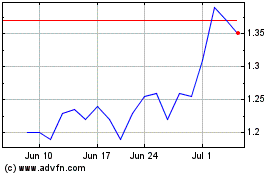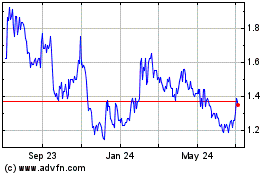UNITED
STATES
SECURITIES AND EXCHANGE COMMISSION
Washington, D.C. 20549
FORM SD
Specialized Disclosure Report
LIGHTPATH TECHNOLOGIES, INC.
(Exact name of registrant as specified in its charter)
|
Delaware
|
|
000-27548
|
|
86-0708398
|
|
(State or other jurisdiction of
incorporation or organization)
|
|
(Commission File Number)
|
|
(I.R.S. Employer
Identification Number)
|
2603 Challenger Tech Court, Suite 100
Orlando, Florida 32826
(Address of principal executive office, including zip
code)
Albert Miranda
(407) 382-4003
(Name and telephone number, including area code, of the person to
contact in connection with this report)
Check the appropriate box to indicate the rule pursuant to which
this form is being filed, and provide the period to which the
information in this form applies:
[ X ]
Rule 13p-1 under the Securities Exchange Act (17 CFR 240.13p-1) for
the reporting period from January 1 to December 31,
2020.
LightPath
Technologies, Inc.
Form
SD
Section 1 – Conflict Minerals Disclosure
Item 1.01 Conflict Minerals Disclosure and Report
Introduction
This
Specialized Disclosure Report on Form SD (this
“Report”) of LightPath Technologies, Inc.
(“LightPath,” the “Company,”
“we,” “our,” or “us”) for the
calendar year ended December 31, 2020 was prepared in accordance
with Rule 13p-1 under the Securities Exchange Act of 1934, as
amended (“Rule 13p-1”). Rule 13p-1, along with Form SD
(collectively, the “Conflict Rules”), require public
companies to annually disclose information about their use of
specific conflict minerals originating and financing armed groups
in the Democratic Republic of the Congo (“DRC”) and
adjoining countries (together with the DRC, “Covered
Countries”) that are “necessary to the functionality or
production of a product” manufactured by those companies or
contracted by those companies to be manufactured. The term
“conflict minerals” includes tantalum, tin, gold or
tungsten.
In
accordance with the Conflict Rules, a copy of this Report is
available on our website at www.lightpath.com under the
“Resources/Certifications, Compliance, Patents/ Conflict
Minders Form SD” tab.
Company Overview
We are
a global, vertically integrated provider of optics, photonics, and
infrared solutions for the industrial, defense, telecommunications,
testing and measurement, and medical industries. We design,
manufacture, and distribute proprietary optical and infrared
components including molded glass aspheric lenses and assemblies,
infrared lenses and thermal imaging assemblies and fused fiber
collimators used to produce products that manipulate light. We also
offer custom optical assemblies, including full engineering design
support. The Company is headquartered in Orlando, Florida, with
manufacturing and sales offices in Riga, Latvia and Shanghai and
Zhenjiang, China.
Our
wholly-owned subsidiary, ISP Optics Corporation
(“ISP”), manufactures a full range of infrared products
from high performance MWIR and LWIR lenses and lens assemblies.
ISP’s infrared lens assembly product line includes athermal
lens systems used in cooled and un-cooled thermal imaging cameras.
Manufacturing is performed in-house to provide precision optical
components including spherical, aspherical, and diffractive coated
infrared lenses. ISP’s optics processes allow it to
manufacture its products from all important types of infrared
materials and crystals. Manufacturing processes include CNC
grinding and CNC polishing, diamond turning, continuous and
conventional polishing, optical contacting and advanced coating
technologies.
Framework of Conflict Minerals Program
Team. We assembled an internal team (the “Team”)
to oversee compliance with the Conflict Rules, including developing
processes and procedures, as well as monitoring developments,
initiatives and “best practices.” The Team consists of
our Chief Financial Officer, Director of Quality, Director of
Engineering, Director of Global Coating, and Supply Chain Manager.
We believe input from various departments is beneficial for the
purpose of overseeing our compliance with the Conflict Rules and
implementing our processes and procedures related to the Conflict
Rules.
Policy Statement. We adopted a policy statement concerning
our principles on the use of conflict minerals from the Covered
Countries and our aim to only use suppliers that source from
conflict-free smelters and refiners. This policy statement can be
found on our website at www.lightpath.com under the
“Resources/Certifications, Compliance/Conflict
Minerals” tab.
Reasonable Country of Origin Inquiry
To be
within the purview of the Conflict Rules, a reporting issuer must
sell products that it manufactures or contracts to manufacture,
such products must contain conflict minerals, and such conflict
minerals must be necessary to the functionality or production of
the products. We sell products that we manufacture or contract to
manufacture, thus meeting these parts of the test. To determine if
any conflict minerals are incorporated into our products, including
parts and components of such products, the Team conducted an
inventory and analysis of all components of our products, which
included reviewing bills of materials, product specifications and
other relevant documentation. The Team concluded that certain of
our products may contain the conflict minerals gold, tantalum,
tungsten and tin. The Team also determined that the conflict
mineral tungsten is used in the molds, rings and sleeves as tooling
necessary to manufacture molded lenses; however, the Conflict Rules
do not require us to take any further action with respect to the
tungsten used in tooling.
Next,
the Team analyzed whether any of the conflict minerals are
“necessary to the functionality of a product” or
“necessary to the production of a product.” To
determine whether any of the conflict minerals are “necessary
to the functionality of a product,” the Team considered
whether a conflict mineral is intentionally added to a product or a
component of a product and is not a naturally occurring by-product,
whether a conflict mineral is necessary to a product’s
generally expected function, use or purpose, and, if any of the
conflict minerals are incorporated for purposes of ornamentation,
decoration or embellishment, whether the primary purpose of such
product is ornamentation, decoration or embellishment. To determine
whether any of the conflict minerals are “necessary to the
production of a product,” the Team considered whether a
conflict mineral is intentionally included in the product’s
production process (other than a conflict mineral included in a
tool, machine or indirect equipment used to produce the product),
whether a conflict mineral is necessary to produce the product and
whether a conflict mineral is included as part of a component of
the product originally manufactured by a third party. The Team
determined the following with respect to each of the listed
conflict minerals:
Gold. At a customer’s request, our precision molded
aspheric lenses may be mounted onto gold-plated holders; however,
during calendar year 2020, no customer requested a gold-plated
holder. One of our collimator applications also may be gold coated
at the request of a customer; however, during calendar year 2020,
no customer requested a gold coated collimator application.
Finally, gold is an ingredient used in the anti-reflective coating
that is applied to some of our lenses at the request of a customer.
The Team concluded that with respect to each of these products,
when used, gold is intentionally added and is necessary to the
products’ generally expected function, use, or
purpose.
Tantalum. Tantalum oxide is an ingredient used in the
anti-reflective coating that is applied to some of our lenses at
the request of a customer. The Team concluded that, when used,
tantalum oxide is intentionally added and is necessary to such
products’ generally expected function, use or
purpose.
Tungsten. Tungsten is an ingredient used in the
manufacturing of the glass preform that is molded into some of our
lenses. The Team concluded that, when used, tungsten is
intentionally added and is necessary to such products’
generally expected function, use or purpose.
Tin. At a customer’s request, one of our collimator
applications may be tin coated. During calendar year 2020, no
customer requested a tin coated collimator application. The Team
concluded that, when used, tin is intentionally added and is
necessary to such products’ generally expected function, use
or purpose.
After
concluding that conflict minerals are necessary to the
functionality of certain of our products, the Team conducted a
reasonable country of origin inquiry based on the OECD Due
Diligence Guidance for Responsible Supply Chains of Minerals from
Conflict-Affected and High-Risk Areas to determine if any of the
conflict minerals in our products for calendar year 2020 originated
in the Covered Countries. We do not purchase conflict minerals
directly from mines, smelters, or refiners and, therefore, there
are many third parties in the supply chain between us and the
original sources of the conflict minerals contained in our
products. Accordingly, our reasonable country of origin inquiry
focused on our first-tier suppliers, and we are relying on these
direct suppliers (and they in turn are relying upon their
suppliers) for information regarding the origin of the any conflict
minerals in our products. The Team identified twenty-nine
first-tier suppliers. The Team sent inquiries to each of these
suppliers regarding whether the supplier supplied to us any
components or parts or sold to us raw materials that contained any
conflict minerals and, if yes, the source of the conflict minerals
either used in components or parts supplied to us or sold to us as
raw materials, and requested each such supplier provide a
representation letter or other written response regarding the
source of the conflict minerals or to complete and return the
Electronic Industry Citizenship Coalition and Global
e-Sustainability (“EICC/GeSI”) Conflict Minerals
Reporting Template. The results of the Team’s inquiries with
respect to each of the listed conflict minerals are as
follows:
Gold. One of our suppliers provided a written response
indicating its or its suppliers’ gold did not originate from
the Covered Countries.
Tantalum. Six of our suppliers provided a written response
indicating its or its suppliers’ tantalum did not originate
from the Covered Countries.
Tungsten. Four of our suppliers provided a written response
indicating its or its suppliers’ tungsten did not originate
from the Covered Countries.
Tin. During calendar year 2020, no customer requested a
product that contained tin and, therefore, we did not purchase tin
from any suppliers. Accordingly, with respect to tin, we did not
take any further action.
Conclusion Based on Reasonable Country of Origin
Inquiry
We have
concluded in good faith that during calendar year 2020, (i) we
manufactured and contracted to manufacture products as to which
conflict minerals are necessary to the functionality or production
of our products and (ii) based on our reasonable country of origin
inquiry, we have no reason to believe that any of the conflict
minerals necessary to the functionality or production of our
products may have originated in the Covered Countries.
Item 1.02 Exhibit
Not
required.
SIGNATURES
Pursuant
to the requirements of the Securities Exchange Act of 1934, as
amended, the registrant has duly caused this Report to be signed on
its behalf by the duly authorized undersigned
|
|
LIGHTPATH
TECHNOLOGIES, INC.
|
|
|
|
|
|
|
|
Date: June
1, 2021
|
By:
|
/s/ Albert
Miranda
|
|
|
|
|
Albert
Miranda
|
|
|
|
|
Chief Financial Officer
|
|
Lightpath Technologies (NASDAQ:LPTH)
Historical Stock Chart
From Mar 2024 to Apr 2024

Lightpath Technologies (NASDAQ:LPTH)
Historical Stock Chart
From Apr 2023 to Apr 2024
